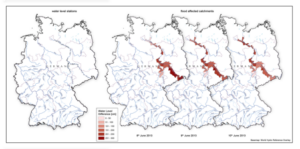- How can we explore geographical relations between social media and authoritative data to enhance information extraction for disaster management?
- How can collaborative maps of OpenStreetMap be used for supporting risk analysis and emergency planing?
These two questions were explored recently by researchers of the GIScience group working on the use of Volunteered Geographic Information for Disaster Management and in the AGORA project.
Prof. João Porto de Albuquerque, visiting professor at Heidelberg, presented two papers related to the use of volunteered geographic information for disaster management at the conference Information Systems for Crisis Response and Management (ISCRAM 2014). The first one is entitled “Does the spatiotemporal distribution of flood-related tweets correspond to the spatiotemporal distribution of floods? A study about the River Elbe Flood in June 2013“. It explores the use of geographical relations between twitter messages and sensor data from official water gauges to reveal that the distribution of flood-related tweets is well related to the distribution of flooded areas, as we can notice in the figures below.


A work further elaborating on this research question called “Exploring the geographical relations between social media and flood phenomena to improve situational awareness: A study about the River Elbe Flood in June 2013“ was presented as a full paper at AGILE conference in Castellón (Spain) by Benjamin Herfort, undergraduate research assistant of the GIScience group.
Another paper presented at ISCRAM 2014 was related to “Identifying Elements at Risk from OpenStreetMap: The Case of Flooding“, where we examine how OSM can be used for risk analysis and emergency planing. This topic was also presented at State of the Map Europe, the main conference related to OpenStreetMap in Europe. The video recording of this talk is available here.
Last but not least, we are currently running a course on Disaster Mapping 2.0, for which the students are having very interesting discussions in a blog. Everybody is welcome to contribute!
Paper References:
HERFORT, B., ALBUQUERQUE, J. P., SCHELLHORN, S., ZIPF, A. (2014) Does the spatiotemporal distribution of flood-related tweets correspond to the spatiotemporal distribution of floods? A study about the River Elbe Flood in June 2013. In 11th International ISCRAM Conference – University Park, Pennsylvania, USA.
HERFORT, B., ALBUQUERQUE, J. P., SCHELHORN, S., ZIPF, A. (2014) Exploring the geographical relations between social media and flood phenomena to improve situational awareness: A study about the River Elbe Flood in June 2013. In 17th AGILE Conference on Geographic Information Science: Connecting a Digital Europe through Location and Place.
SCHELHORN, S. J.; ALBUQUERQUE, J. P.; ZIPF, A.; LEINER, R.; HERFORT, B. (2014): Identifying Elements at Risk from OpenStreetMap: The Case of Flooding. In 11th International ISCRAM Conference – University Park, Pennsylvania, USA.


